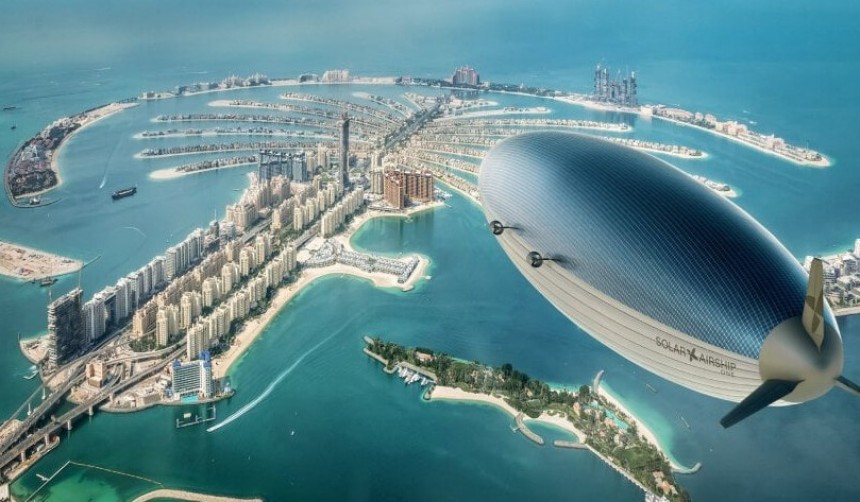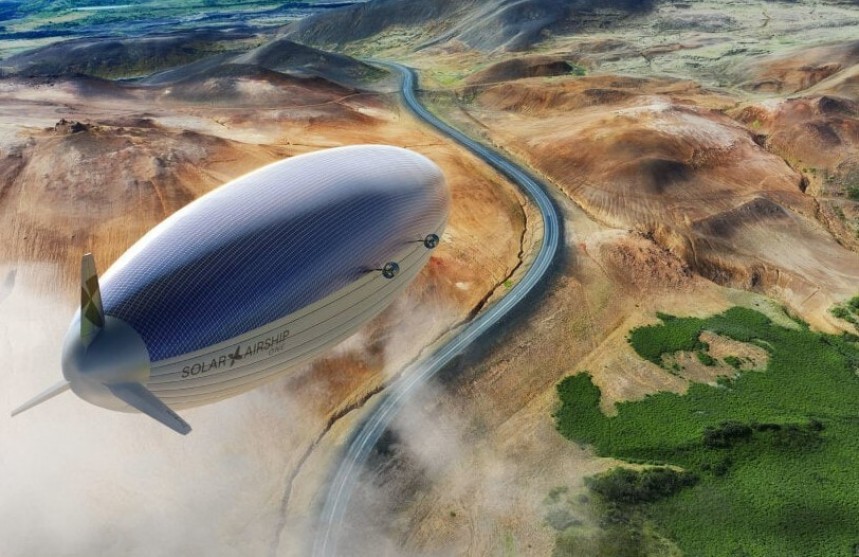This isn't inviting bad karma, it's learning from past mistakes. Rigid airships are making a comeback, but perhaps few others are as bold as the Solar Airship One project.
The airship era effectively ended with the 1937 Hinderburg Disaster, but we're about to witness a comeback of these gentle giants of the sky. Rigid airships with hybrid propulsion promise to lead the way to full decarbonization of all aerial travel, from freight transports to humanitarian missions and air tourism.
Rigid airships promise a much lower carbon footprint compared to traditional aircraft, a much bigger volume to carry either cargo or passengers and smoother travels.
In the case of the upcoming Solar Airship One, we're also promised the possibility of flying forever without needing to touch ground to resupply. Not that this would ever be a real-life goal, but it could happen. The Solar Airship One might sound like a dream, and you're to read "dream" with a pejorative connotation, but it's a real airship with plans to take to the skies as early as 2026.
Developed by French company Euro Airship, the Solar Airship One is a demonstrator for a new approach to rigid airships that will later translate into three different models – and different sizes, to suit a variety of purposes, including military and civilian. It's been in the works for the past 10 years, with the more recent three including over 100 engineers from Capgemini for the pre-production stage.
The Solar Airship One is real, even though no photo of the actual demonstrator has been made public as of this writing. Euro Airship believes it's the future of human flight, paving the way to the complete decarbonization of the industry because it features hybrid solar-hydrogen propulsion and because it offers advantages no conventional aircraft could.
These advantages range from a massive volume to the ability to fly with no emissions, no fossil fuels, no noise, and no heavy infrastructure on the ground. It is, as Euro Airship says, "a jewel of technology, energy efficiency, and safety."
The Solar Airship One is a whale-shaped aircraft measuring 151 meters (495.4 feet) in length and with a helium volume of 50,000 cubic meters (1,765,733 cubic feet).
The double-layered envelope is covered in 4,800 square meters (51,666 square feet) of solar film so that it's able to fly by using solar energy during the day and hydrogen propulsion at night. Energy stored throughout the day in fuel cells is used to produce hydrogen through water electrolysis.
The airship has 15 gas envelopes managed separately by AI, offering an instant response and anticipation of meteorological events, and countering helium inertia. The "sturdy" structure is covered with a double-layered reinforced envelope to mitigate differences in pressure and temperature during travel, which means that the airship will know no limits as regards travel routes or heights.
For landing, the Solar Airship One will use a classic water ballast system and a compressed-air-based system that is still in development. According to Euro Airship, a single rotating platform on any water surface is all the infrastructure needed to land it.
In 2026, the Solar Airship One will be taking to the skies with three pilots – and flight pioneers – onboard for what will be a historical, record-breaking trip: the first non-stop flight around the globe in a rigid airship with green propulsion.
Bertrand Piccard, a pilot whose achievements include the first non-stop flight in a hot-air balloon and the first non-stop flight in a solar plane, Michel Tognini, an experienced ESA astronaut, and Dorine Bourneton, the first disabled female aerobatic pilot, will pilot the airship on this groundbreaking flight.
It will cover more than 40,000 km (21,600 nautical miles) from West to East over 20 or 30 days at an average altitude of 6,000 meters (19,700 feet). The airship will keep close to the Equator and will fly over 25 countries, with the pilots onboard maintaining contact with local authorities, universities, and international groups as they make their way around the globe.
Euro Airship also promises full coverage of the flight on social media and a following documentary, so members of the general public will be able to tag along for the ride.
Dubbed the "commercial airship of the future," Solar Airship One proposes an 80% decrease in fuel consumption and CO2 emissions compared to traditional aircraft and promises real-life applicability ranging from military operations to eco-responsible tourism. It will be "the demonstrator of a reality:" the reality of net-zero, limitless flight.
"The goal is to educate, to catalyze the young generation, for us it is very important because of the climate change, because of the natural disasters coming," Bourneton says in a statement. "That we need to have a new mobility - a green mobility."
Construction on the Solar Airship One will begin in 2024, with assembly scheduled for the following year. After the demonstration flight, Euro Airship plans on pursuing proper certification to launch the rigid airship on the market in several models, including one that doesn't have solar panels and comes with a limited range of 1,000 km (540 nautical miles).
Rigid airships promise a much lower carbon footprint compared to traditional aircraft, a much bigger volume to carry either cargo or passengers and smoother travels.
In the case of the upcoming Solar Airship One, we're also promised the possibility of flying forever without needing to touch ground to resupply. Not that this would ever be a real-life goal, but it could happen. The Solar Airship One might sound like a dream, and you're to read "dream" with a pejorative connotation, but it's a real airship with plans to take to the skies as early as 2026.
The Solar Airship One is real, even though no photo of the actual demonstrator has been made public as of this writing. Euro Airship believes it's the future of human flight, paving the way to the complete decarbonization of the industry because it features hybrid solar-hydrogen propulsion and because it offers advantages no conventional aircraft could.
These advantages range from a massive volume to the ability to fly with no emissions, no fossil fuels, no noise, and no heavy infrastructure on the ground. It is, as Euro Airship says, "a jewel of technology, energy efficiency, and safety."
The double-layered envelope is covered in 4,800 square meters (51,666 square feet) of solar film so that it's able to fly by using solar energy during the day and hydrogen propulsion at night. Energy stored throughout the day in fuel cells is used to produce hydrogen through water electrolysis.
The airship has 15 gas envelopes managed separately by AI, offering an instant response and anticipation of meteorological events, and countering helium inertia. The "sturdy" structure is covered with a double-layered reinforced envelope to mitigate differences in pressure and temperature during travel, which means that the airship will know no limits as regards travel routes or heights.
In 2026, the Solar Airship One will be taking to the skies with three pilots – and flight pioneers – onboard for what will be a historical, record-breaking trip: the first non-stop flight around the globe in a rigid airship with green propulsion.
Bertrand Piccard, a pilot whose achievements include the first non-stop flight in a hot-air balloon and the first non-stop flight in a solar plane, Michel Tognini, an experienced ESA astronaut, and Dorine Bourneton, the first disabled female aerobatic pilot, will pilot the airship on this groundbreaking flight.
It will cover more than 40,000 km (21,600 nautical miles) from West to East over 20 or 30 days at an average altitude of 6,000 meters (19,700 feet). The airship will keep close to the Equator and will fly over 25 countries, with the pilots onboard maintaining contact with local authorities, universities, and international groups as they make their way around the globe.
Dubbed the "commercial airship of the future," Solar Airship One proposes an 80% decrease in fuel consumption and CO2 emissions compared to traditional aircraft and promises real-life applicability ranging from military operations to eco-responsible tourism. It will be "the demonstrator of a reality:" the reality of net-zero, limitless flight.
"The goal is to educate, to catalyze the young generation, for us it is very important because of the climate change, because of the natural disasters coming," Bourneton says in a statement. "That we need to have a new mobility - a green mobility."
Construction on the Solar Airship One will begin in 2024, with assembly scheduled for the following year. After the demonstration flight, Euro Airship plans on pursuing proper certification to launch the rigid airship on the market in several models, including one that doesn't have solar panels and comes with a limited range of 1,000 km (540 nautical miles).















